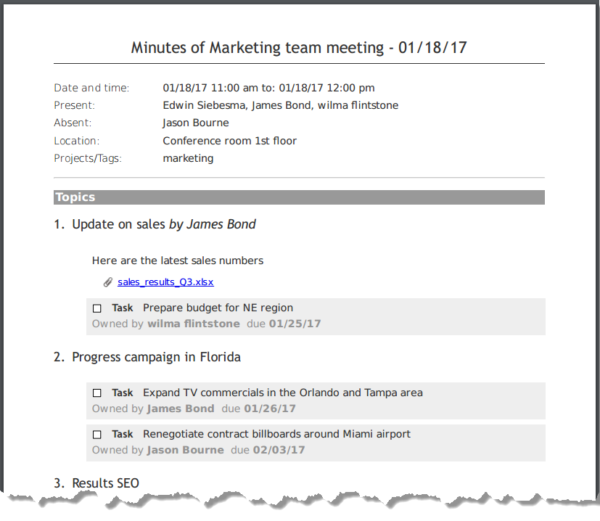How to Write Meeting Minutes
Writing good meeting minutes can save time and money. Succinct minutes that capture the purpose of the meeting and its agreed outcomes are a record that can be referred back to and be used for follow up purposes later. Good minutes are concise and to the point, but at the same time, they do not leave out critical information.
Why write meeting minutes?

Writing minutes can take time, and may seem like an unimportant task compared with getting on with “real work”, but in fact not taking meeting minutes can be costly in terms of both time and resources. If you don’t take minutes, you will find that your colleagues have different recollections from the meeting than you. They also may have different ideas about what was agreed. If there are no minutes, then important tasks will be forgotten or not achieved by the due date.
Creating meeting minutes provides a written record of what was agreed at a meeting. Good meeting minutes tell people what was decided and what they need to achieve and by what date. When meeting minutes are received it jogs memories about tasks that people need to do. If a task is not performed then you can refer back to the meeting minutes and follow up on it. Without meeting minutes, you have no recourse if an action was not carried out. In the worst case, if meeting minutes are not written you may end up having to repeat the meeting.
In some instances, meeting minutes may be required for legal reasons. An example of this is where local bylaws require it for certain types of organizations. Also, they may be required for disciplinary meetings with employees. Getting into the habit of taking meeting minutes is good practice.
What needs to be included?
When you are writing meeting minutes you need to include different kinds of information. You should include the reason for the meeting, what it was about and where and when it was held. It is important to include a list of the attendees – both their first and last names. If you are not sure, you need to ask to make sure that you get the names right, otherwise your meeting minutes may be a source of irritation for attendees. If someone did not attend but it was important that they did, this should be included. For example, sometimes decisions cannot be made without a particular person being present.
There are three other main items that should be included in your minutes:
- What was achieved during the meeting.
- Decisions that were made at the meeting. Your minutes will serve as a written record that these decisions were made.
- Any actions that were agreed. In this case you should include the action itself, who it was assigned to, and the date it should be completed by.
Finally, if a follow-up meeting was agreed on, this should be mentioned.
How can MeetingKing help?
MeetingKing offers a lot of features that can help improve your minute taking, including:
- Ability to take notes and assign tasks in one application
- Bullet style recording
- One-click minutes at end of meeting
- One central up-to-date document (minutes won’t get lost in inbox or on server)
- Easy access for all participants to provide updates and comments
- Platform to deliver materials for assigned tasks
- Tasks linking between meetings
- One place for all attachments
- The agenda serves as template for minutes
- Serves as a basis for the notes and minutes during the meeting
- Invitees are NOT required to have a MeetingKing account
Want to find out more? See how MeetingKing makes it easy to write meeting minutes.
Get started now. It’s Free!
